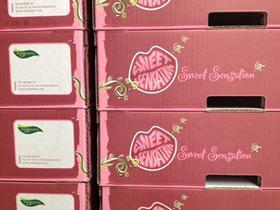
Dutch pear grower-exporters and their Chinese importers are gearing up for the first-ever sea shipments of the fruit to the People's Republic.
The Chinese market officially opened its doors to Dutch pears on 3 November, and the first seafreight shipments left the Netherlands on 20 November, according to major grower-marketer The Greenery, which expects the maiden containers to arrive around 21 December.
Bert Wilschut, topfruit produce manager at The Greenery, said the focus for this first season would be on introducing Dutch pears as a high-quality offering to the Chinese market, rather than on selling high volumes.
Conference pears will make up the bulk of shipments from Holland, and while very different in look and taste to Chinese pears, Wilschut is confident the variety will be well accepted by Chinese consumers.
“We organised some tastings for our Chinese customers in June during the official China introduction for Conference pears, which was held at the International Horticultural Exhibition in Qingdao,” he explained.
“We found that they really liked this pear, even though it has a different appearance to Chinese varieties. The Conference pear is not a complete stranger to the Chinese market as Belgian Conference has already been on the market there for four years.”
In addition to Conference, The Greenery is excited about the prospects for Sweet Sensation, a red-blush sweet pear to which it holds the exclusive rights.
“We already did some market research on the appearance of Sweet Sensation in Asian countries and, thanks to its beautiful colour and great taste, it was well appreciated,” Wilschut added.
Nevertheless, a significant amount of consumer education will be required for such pear varieties to take off in China. Very few Chinese consumers know how to eat this type of western pear, which is usually very firm at the time of purchase with little flavour, and must be left to ripen for a few days before it is ideal to eat. If consumers are put off by the appearance or lack of knowledge of the fruit, it could fail to catch on, but an encouraging response to the opening of the market from key players in the Chinese import trade suggest a following will be created.
The Greenery has selected three importers to work with this season in China, and its marketing is supported by Dalice Trading, its local joint venture company based in Qingdao, which acts as a service provider to the importers.
Goodfarmer hosts launch event
One of those importers is Goodfarmer, which is holding a launch event in Beijing today (19 December) for Dutch pears to introduce them to its customers.
“We’re hosting a new product release conference in Beijing to formally introduce Dutch pears to our clients,” explained the company’s Kayla Yang. “We’ve invited our key clients both in the retail and wholesale markets and we’re sharing professional product knowledge on areas such as a selection, storage and ripening as well as information on the nutritional value and so on. By sharing this information with them, we hope they can help their customers better understand Dutch pears.”
In addition to the trade outreach, Goodfarmer plans to hire a professional marketing company to help coordinate launch events and tastings with supermarkets around China, Yang notes. “At the same time, our online store partners will undertake more detailed and dynamic activities to introduce the pears to younger consumers,” she added.
While Goodfarmer is not an exclusive agency for any Dutch pear supplier, she says the company is keen to invest in market development for the product to demonstrate the importer’s commitment to suppliers.
Goodfarmer expects its first two container loads of Dutch pears to arrive around 25 December. “We’ve got one container coming from The Greenery, and one from another supplier, and we expect them to clear customs by around 27 December,’ said Yang.
Yang admitted that it would be difficult at the beginning to sell Dutch pears to Chinese consumers, given their differences to local varieties, but she says those unique qualities are also a selling point.
“The Dutch pears taste really good when eaten at the right time, so the key is to introduce the product in the right way and sell it at the right time,” she said. “We think there are bright prospects, once Chinese consumers know how to select and eat Dutch pears.”
Goodfarmer plans to sell Dutch pears under supplier brands, rather than its own brand, to begin with, in order to build up awareness of the country of origin. “We hope that Holland can become popular among Chinese customers for its sweet and juicy pears,” she said.
The Greenery has selected key growers, packhouses and coldstorage operators within its group to comply with the requirements of the Chinese protocol. Wilschut says the company has around 1,250 tonnes of Sweet Sensation production and 3,500 tonnes of Conference pear production that complies with the protocol.






No comments yet